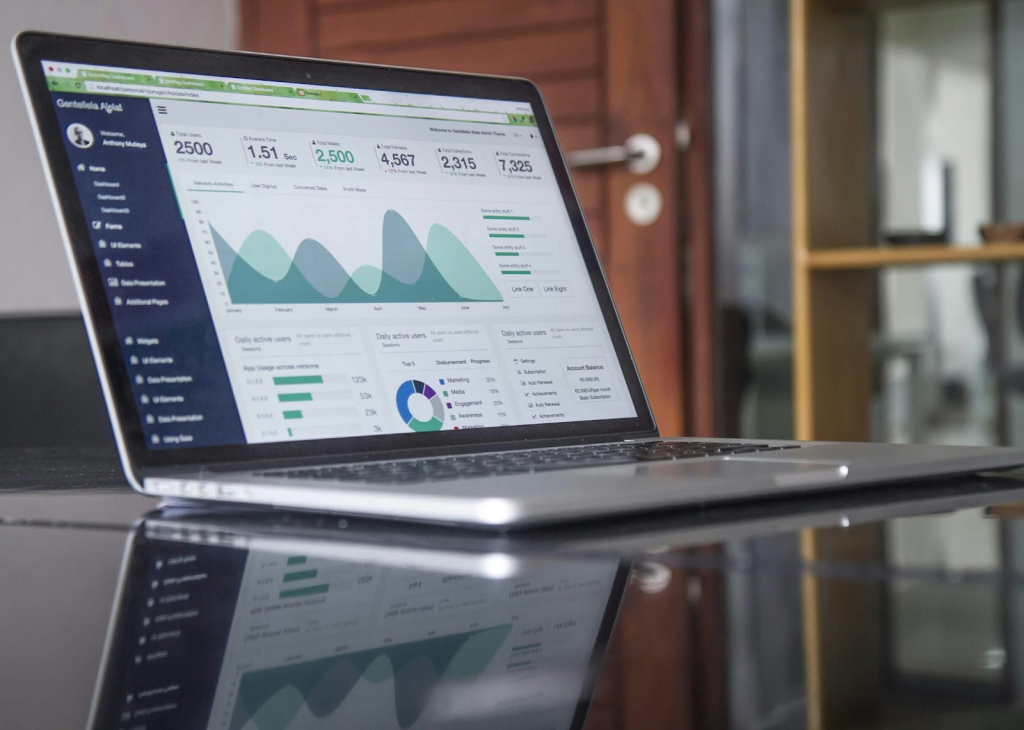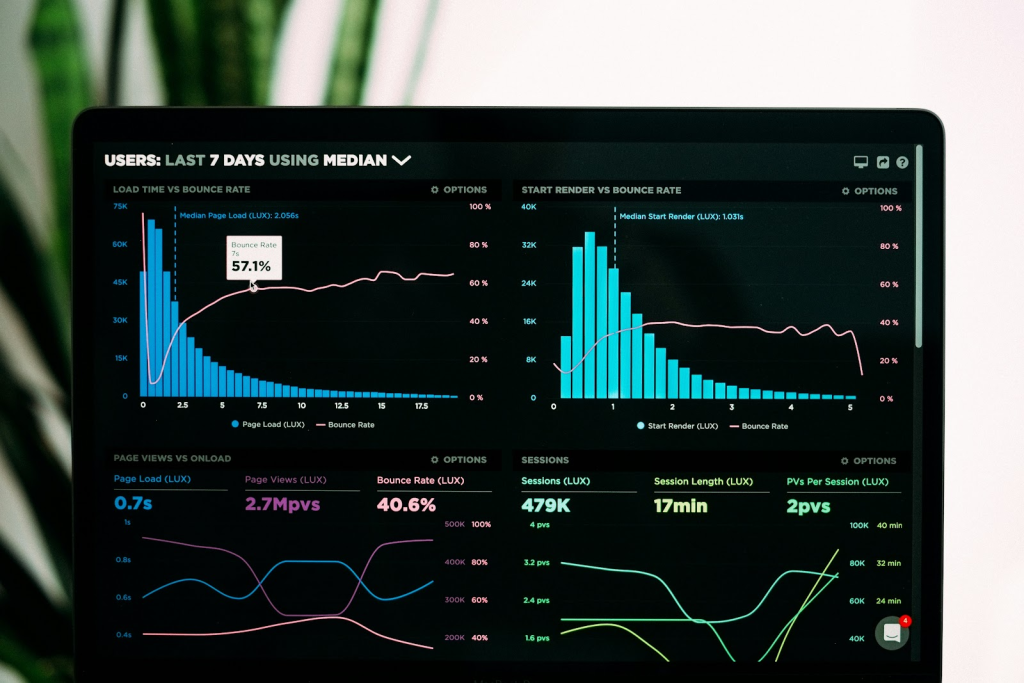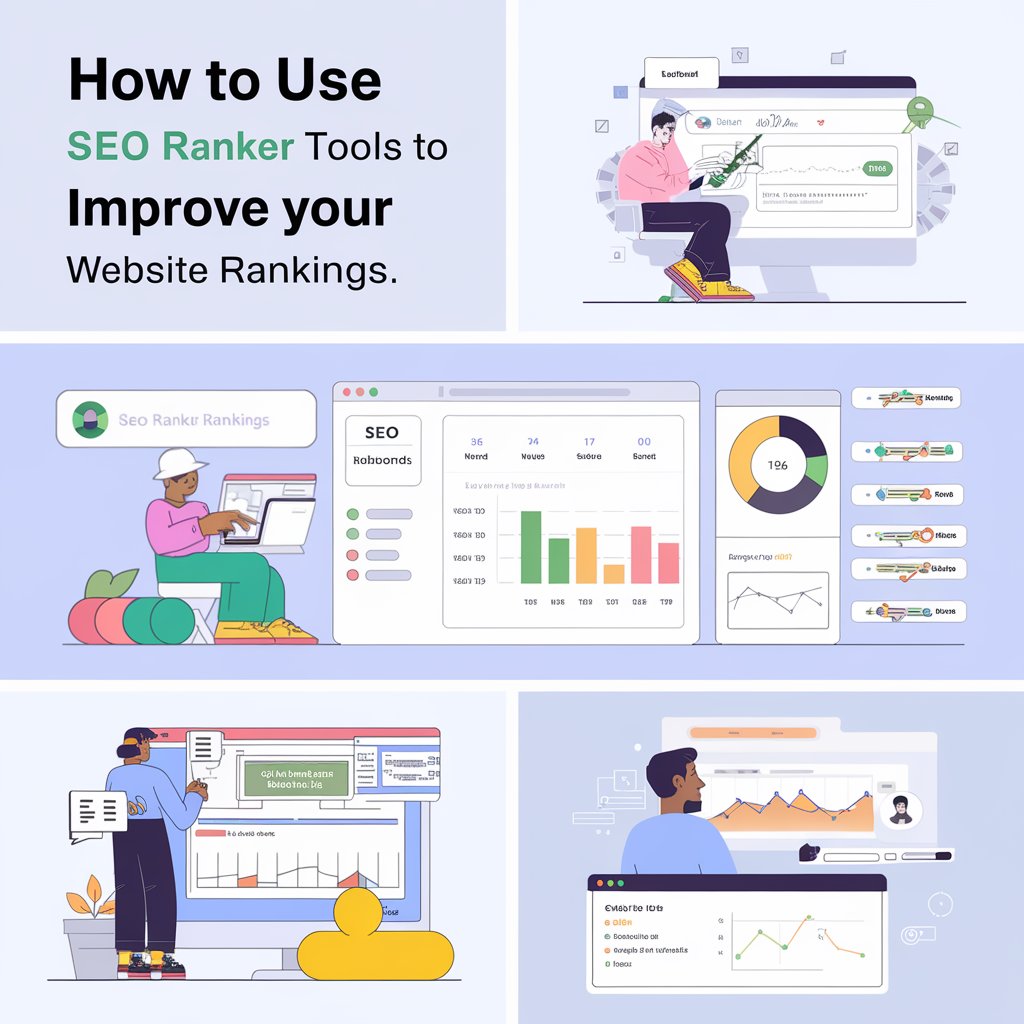How to Use SEO Ranker Tools to Improve Your Website Rankings
Your website’s visibility on search engines can make or break your success. This is where Search Engine Optimization (SEO) comes into play. SEO is a complex field, with many factors influencing your website’s ranking on search engine results pages (SERPs). One of the most effective ways to manage and improve your SEO is by using SEO ranker tools. These tools provide valuable insights into your website’s performance. They help you understand how your site is perceived by search engines.

But what exactly are SEO ranker tools? In essence, they are software solutions that track your website’s position on SERPs for specific keywords. They provide data on your site’s visibility, the effectiveness of your SEO strategies, and areas for improvement. These tools can also monitor your competitors’ performance, giving you valuable insights into their strategies. But simply having an SEO ranker tool is not enough.
You need to know how to use it effectively. This comprehensive guide aims to help you do just that. We will delve into the features and functionalities of SEO ranker tools. We will discuss how to interpret the data they provide and how to apply this information to optimize your website. Whether you’re an SEO professional, a digital marketer, a website owner, or a content creator, this guide will equip you with the knowledge to improve your website’s search engine rankings. Let’s get started.
Understanding SEO Ranker Tools and Their Importance
SEO ranker tools are an essential part of any digital marketer’s toolkit. They provide a wealth of information about your website’s performance in search engine rankings. But what exactly are these tools, and why are they so important?
What Are SEO Ranker Tools?
SEO ranker tools, also known as SEO rank tracking tools or SEO position checkers, are software solutions designed to monitor and analyze a website’s performance on search engine results pages (SERPs). They track your website’s ranking for specific keywords over time. This allows you to see how your SEO efforts are impacting your visibility on search engines like Google. These tools can also provide insights into your competitors’ performance, helping you understand where you stand in your industry.
The Role of SEO Ranker Tools in Digital Marketing
In the world of digital marketing, data is king. SEO ranker tools provide the data you need to make informed decisions about your SEO strategy. They can show you which of your targeted keywords are performing well, and which ones might need more attention.

- They can help you identify new keyword opportunities.
- They can show you how changes to your website or updates to search engine algorithms are affecting your rankings.
- They can provide insights into your competitors’ strategies, helping you stay competitive.
Key Features of Effective SEO Ranker Tools
When choosing an SEO ranker tool, there are several key features to look for. These features can greatly enhance your ability to monitor and improve your website’s SEO performance.

- Keyword tracking: This allows you to monitor your website’s ranking for specific keywords over time.
- Competitor analysis: This feature provides insights into your competitors’ keyword strategies and their performance on SERPs.
- Backlink analysis: This helps you understand who is linking to your website and how these backlinks are affecting your SEO.
- SEO audit: This feature scans your website for common SEO issues and provides recommendations for improvement.
- Reporting and analytics: This provides a detailed analysis of your SEO performance, helping you understand what’s working and what’s not.
By understanding these features and how to use them effectively, you can leverage SEO ranker tools to significantly improve your website’s search engine rankings.
Setting Up Your SEO Ranker Tools
Once you understand the importance of SEO ranker tools and the key features to look for, the next step is setting them up. This process can vary depending on the specific tool you choose. However, there are some general steps that you can follow to get started.
Choosing the Right SEO Ranker Tool for Your Needs
The first step in setting up your SEO ranker tools is choosing the right one for your needs. There are many different tools available, each with its own strengths and weaknesses.

Some tools may specialize in certain areas, such as backlink analysis or competitor research. Others may offer a more comprehensive suite of features. When choosing a tool, consider your specific needs and goals. For example, if you’re primarily interested in tracking your keyword rankings, a tool with strong keyword tracking capabilities would be a good choice. On the other hand, if you’re looking to conduct a comprehensive SEO audit, you might want a tool that offers a wide range of features.
Step-by-Step Guide to Setting Up an SEO Position Checker
Once you’ve chosen your SEO ranker tool, the next step is setting it up. Here’s a general step-by-step guide to setting up an SEO position checker:
- Sign up for an account: Most SEO ranker tools require you to create an account. This usually involves providing your email address and creating a password.
- Add your website: After creating an account, the next step is to add your website to the tool. This usually involves entering your website’s URL and possibly verifying ownership.
- Choose your keywords: Next, you’ll need to choose the keywords you want to track. These should be keywords that are relevant to your website and that you’re actively targeting in your SEO efforts.
- Set up your competitors: Many SEO ranker tools allow you to track your competitors’ performance as well. To do this, you’ll need to enter the URLs of your competitors’ websites.
- Start tracking: Once everything is set up, you can start tracking your website’s performance. Most tools will provide you with a dashboard where you can see your rankings, track changes over time, and analyze other aspects of your SEO performance.
Remember, setting up your SEO ranker tool is just the first step. The real value comes from regularly monitoring your performance, analyzing the data, and making adjustments to your SEO strategy as needed.
SEO Rank Monitoring and Analytics
SEO rank monitoring and analytics are crucial aspects of any successful SEO strategy. They provide valuable insights into your website’s performance and help you make data-driven decisions. In this section, we’ll discuss how to monitor your SEO rankings effectively and how to interpret the data from SEO analytics.
How to Monitor Your SEO Rankings Effectively
Monitoring your SEO rankings involves more than just checking where your website ranks for certain keywords. It’s about understanding the factors that influence your rankings and how you can optimize your website to improve them.
Here’s a step-by-step guide on how to monitor your SEO rankings effectively:
- Choose the right keywords: The first step in SEO rank monitoring is choosing the right keywords. These should be relevant to your website and reflect what your target audience is searching for.
- Use an SEO ranker tool: An SEO ranker tool can automate the process of tracking your keyword rankings. It can provide you with real-time data and show you how your rankings change over time.
- Monitor your competitors: Keeping an eye on your competitors can provide valuable insights. You can learn from their successes and failures and adjust your strategy accordingly.
- Track your progress over time: SEO is a long-term game. It’s important to track your progress over time and not get discouraged by short-term fluctuations in your rankings.
- Analyze and adjust: Based on your monitoring, you should analyze your performance and make necessary adjustments. This could involve tweaking your keywords, improving your content, or optimizing your website’s technical aspects.
Remember, effective SEO rank monitoring is not a one-time task. It’s an ongoing process that requires regular attention and adjustment.
Interpreting Data from SEO Analytics
SEO analytics provide a wealth of data about your website’s performance. But this data is only useful if you know how to interpret it.
Here are some key metrics to pay attention to when interpreting data from SEO analytics:
- Organic traffic: This is the number of visitors who come to your website through organic search results. Increasing organic traffic is a key goal of SEO.
- Bounce rate: This is the percentage of visitors who leave your website after viewing only one page. A high bounce rate could indicate that your content is not meeting the needs of your visitors.
- Average session duration: This is the average amount of time that visitors spend on your website. A longer session duration suggests that visitors are finding your content valuable and engaging.
- Pages per session: This is the average number of pages that visitors view during a single visit. More pages per session can indicate that your website is well-structured and your content is engaging.
- Top exit pages: These are the pages from which visitors most often leave your website. If a particular page has a high exit rate, it could indicate a problem with that page.

Interpreting data from SEO analytics can help you understand how your website is performing and where there’s room for improvement. By focusing on these key metrics, you can make data-driven decisions that improve your SEO strategy and boost your rankings.

Remember, the goal of SEO analytics is not just to collect data. It’s to use that data to gain insights and make informed decisions that improve your website’s performance and visibility in search engine results.
Leveraging SEO Ranker Tools for On-Page Optimization
On-page optimization is a key aspect of SEO. It involves optimizing the content and HTML source code of a page to make it more search engine-friendly. In this section, we’ll discuss how to leverage SEO ranker tools for on-page optimization. We’ll cover both content optimization and technical SEO.
Optimizing Content for SEO with Ranker Tools
Content is king in the world of SEO. But creating high-quality content is not enough. You also need to optimize it for search engines.
Here’s how you can use SEO ranker tools to optimize your content:
- Keyword optimization: SEO ranker tools can help you identify the best keywords to target in your content. They can also suggest related keywords to include.
- Content structure: SEO ranker tools can analyze your content structure and suggest improvements. This could involve adding headings, breaking up long paragraphs, or including bullet points.
- Meta tags: SEO ranker tools can help you optimize your meta tags. This includes the title tag, meta description, and header tags.
- Image optimization: SEO ranker tools can suggest ways to optimize your images. This could involve adding alt text, compressing the images, or changing the file names.
- Internal linking: SEO ranker tools can analyze your internal linking structure and suggest improvements. This can help search engines understand the content of your website and improve your SEO.

Remember, content optimization is not a one-time task. It’s an ongoing process that requires regular updates and improvements.
Technical SEO: Improving Site Structure and Performance
Technical SEO involves optimizing your website’s structure and performance to improve its visibility in search engine results. Here’s how you can use SEO ranker tools to improve your technical SEO:
- Site speed: SEO ranker tools can analyze your site speed and suggest ways to improve it. This could involve compressing images, minifying CSS and JavaScript, or implementing lazy loading.
- Mobile optimization: SEO ranker tools can check how mobile-friendly your website is and suggest improvements. This is crucial as more and more people are using mobile devices to browse the web.
- URL structure: SEO ranker tools can analyze your URL structure and suggest improvements. A clear and concise URL structure can improve your SEO and user experience.
- Sitemap: SEO ranker tools can help you create and optimize your sitemap. A well-structured sitemap can help search engines understand and index your website.
- Robots.txt: SEO ranker tools can help you create and optimize your robots.txt file. This file tells search engines which pages to crawl and which to ignore.

Remember, technical SEO is a crucial aspect of SEO. It can significantly impact your website’s visibility in search engine results. By leveraging SEO ranker tools, you can identify and fix technical issues and improve your website’s performance.
Off-Page Optimization with Backlink Checkers and More
Off-page optimization is another crucial aspect of SEO. It involves strategies that improve your website’s position in search engine results pages (SERPs) but happen outside of your website. These strategies primarily involve building high-quality backlinks and improving social signals. In this section, we’ll discuss how to use SEO ranker tools for off-page optimization.
Using Backlink Checkers to Analyze and Build Links
Backlinks are links from other websites that point to your website. They are a crucial factor in how search engines rank websites.
Here’s how you can use backlink checkers to analyze and build links:
- Analyze your backlink profile: Backlink checkers can provide a detailed analysis of your backlink profile. This includes the number of backlinks, the quality of these backlinks, and the anchor text used.
- Identify toxic backlinks: Backlink checkers can identify toxic or harmful backlinks that could be hurting your SEO. Once identified, you can take steps to remove these backlinks.
- Find link-building opportunities: Backlink checkers can help you find link-building opportunities. This could involve identifying websites that are relevant to your industry and could potentially link to your website.
- Monitor your backlinks: Backlink checkers can monitor your backlinks and notify you when you gain or lose backlinks. This can help you keep track of your link-building efforts.
- Analyze competitor backlinks: Backlink checkers can analyze your competitors’ backlinks. This can provide valuable insights into their link-building strategies and help you identify potential link-building opportunities.
Remember, building high-quality backlinks is a long-term process. It requires consistent effort and a strategic approach.
Social Signals and Their Impact on SEO Rankings
Social signals refer to the likes, shares, votes, pins, or views people place on Facebook, Twitter, LinkedIn, or other social media sites that filter out to the various search engines. While the impact of social signals on SEO rankings is a topic of ongoing debate, there’s no denying that a strong social media presence can help improve your SEO.
Here’s how you can use SEO ranker tools to improve your social signals:
- Monitor your social media presence: SEO ranker tools can monitor your social media presence and provide insights into your performance. This includes the number of likes, shares, comments, and followers.
- Identify popular content: SEO ranker tools can identify which of your content is popular on social media. This can provide valuable insights into what type of content resonates with your audience.
- Track competitor performance: SEO ranker tools can track your competitors’ social media performance. This can provide valuable insights into their social media strategies and help you identify areas for improvement.
- Schedule posts: Some SEO ranker tools allow you to schedule social media posts. This can help you maintain a consistent social media presence and reach your audience when they are most active.
- Analyze social media traffic: SEO ranker tools can analyze the traffic you receive from social media. This can help you understand the impact of your social media efforts on your website traffic and SEO.

Remember, social media is a powerful tool for building brand awareness and engaging with your audience. By leveraging SEO ranker tools, you can optimize your social media strategy and potentially improve your SEO.
Advanced SEO Ranker Tool Features
SEO ranker tools come with a variety of advanced features. These features can provide deeper insights into your SEO performance and help you stay ahead of your competitors. In this section, we’ll discuss two of these advanced features: competitor analysis and SERP feature opportunities.
Competitor Analysis and Benchmarking with SEO Tools
Competitor analysis is a crucial part of any SEO strategy. It involves analyzing your competitors’ SEO strategies to identify their strengths and weaknesses.
Here’s how you can use SEO ranker tools for competitor analysis and benchmarking:
- Identify your competitors: SEO ranker tools can help you identify your main competitors based on your target keywords.
- Analyze competitor keywords: SEO ranker tools can analyze your competitors’ keywords. This can provide insights into their keyword strategy and help you identify potential keyword opportunities.
- Benchmark your SEO performance: SEO ranker tools can benchmark your SEO performance against your competitors. This can help you understand where you stand and identify areas for improvement.
- Analyze competitor backlinks: SEO ranker tools can analyze your competitors’ backlinks. This can provide insights into their link-building strategies and help you identify potential link-building opportunities.
- Track competitor social signals: SEO ranker tools can track your competitors’ social signals. This can provide insights into their social media strategies and help you identify areas for improvement.
Remember, competitor analysis is not about copying your competitors’ strategies. It’s about learning from their successes and failures and finding ways to outperform them.
Identifying and Targeting SERP Feature Opportunities
SERP features are special results that appear on Google’s search results pages. They include featured snippets, local packs, knowledge panels, and more.
Here’s how you can use SEO ranker tools to identify and target SERP feature opportunities:
- Identify SERP feature opportunities: SEO ranker tools can identify SERP feature opportunities for your target keywords. This can help you optimize your content to appear in these features.
- Track your SERP feature rankings: SEO ranker tools can track your rankings for different SERP features. This can help you understand your performance and identify areas for improvement.
- Analyze competitor SERP features: SEO ranker tools can analyze your competitors’ SERP features. This can provide insights into their strategies and help you identify potential opportunities.
- Optimize for SERP features: SEO ranker tools can provide recommendations on how to optimize your content for different SERP features. This can increase your chances of appearing in these features and driving more traffic to your website.
- Monitor SERP feature changes: SEO ranker tools can monitor changes in SERP features. This can help you stay up-to-date with the latest trends and adapt your strategy accordingly.

Remember, appearing in SERP features can significantly increase your visibility on search engine results pages. By leveraging SEO ranker tools, you can identify and target these opportunities to drive more traffic to your website.
Common SEO Ranking Issues and How to Fix Them
SEO is a complex field. There are many factors that can affect your website’s rankings on search engines. In this section, we’ll discuss some common SEO ranking issues and how you can use SEO ranker tools to identify and fix them.
Identifying Common SEO Issues with Rank Tracking Tools
SEO ranker tools can help you identify a variety of SEO issues. These issues can range from technical problems to content-related issues.
Here’s how you can use SEO ranker tools to identify common SEO issues:
- Technical SEO issues: SEO ranker tools can identify technical issues like broken links, slow page speed, and crawl errors. These issues can negatively affect your SEO rankings.
- Content-related issues: SEO ranker tools can identify content-related issues like duplicate content, thin content, and keyword stuffing. These issues can also negatively affect your SEO rankings.
- Backlink issues: SEO ranker tools can identify backlink issues like low-quality backlinks and unnatural link patterns. These issues can lead to penalties from search engines.
- On-page SEO issues: SEO ranker tools can identify on-page SEO issues like missing meta tags, poor URL structure, and lack of keyword optimization. These issues can prevent your pages from ranking well on search engines.
- Mobile optimization issues: SEO ranker tools can identify mobile optimization issues like poor mobile usability and slow mobile page speed. These issues can affect your rankings on mobile search results.
Remember, identifying SEO issues is the first step towards improving your SEO rankings. By leveraging SEO ranker tools, you can identify these issues and take steps to fix them.
Tips for Fixing SEO Issues and Improving Rankings
Once you’ve identified your SEO issues, the next step is to fix them. Here are some tips on how you can use SEO ranker tools to fix common SEO issues and improve your rankings:
- Fix technical SEO issues: SEO ranker tools can provide recommendations on how to fix technical SEO issues. This can involve fixing broken links, improving page speed, and resolving crawl errors.
- Improve your content: SEO ranker tools can provide recommendations on how to improve your content. This can involve removing duplicate content, adding more depth to your content, and optimizing your content for keywords.
- Clean up your backlink profile: SEO ranker tools can help you clean up your backlink profile. This can involve removing low-quality backlinks and building high-quality backlinks.
- Optimize your on-page SEO: SEO ranker tools can provide recommendations on how to optimize your on-page SEO. This can involve adding meta tags, improving your URL structure, and optimizing your content for keywords.
- Improve your mobile optimization: SEO ranker tools can provide recommendations on how to improve your mobile optimization. This can involve improving mobile usability and improving mobile page speed.
Remember, fixing SEO issues can significantly improve your SEO rankings. By leveraging SEO ranker tools, you can identify and fix these issues to improve your website’s visibility on search engines.
Conclusion: Continuous Improvement and SEO Success
SEO is not a one-time task. It requires continuous monitoring and improvement.
The Importance of Regular SEO Monitoring and Updates
Regular monitoring of your SEO performance is crucial. It helps you understand how your strategies are working and where improvements are needed. SEO ranker tools can provide you with real-time data. This data can guide your SEO strategies and help you make data-driven decisions.
Staying Ahead of the Curve with SEO Ranker Tools
Staying ahead in the SEO game is not easy. But with the right tools, it’s possible. SEO ranker tools can provide you with insights into your competitors’ strategies. They can also help you identify new opportunities for growth.

In conclusion, SEO ranker tools are essential for any business looking to improve their website’s search engine rankings. By leveraging these tools, you can gain a competitive edge and achieve SEO success.



Hey i am for the first time here. I came across this board and I
find It truly useful & it helped me out much.
I am hoping to present one thing again and aid others such as
you helpd me.